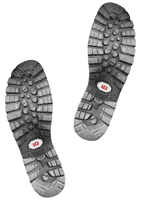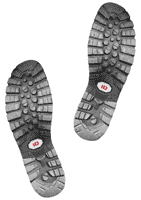
Every Step You Take
Processing facility watches employees’ time and attendance with ID cards
- By Sharon Steinhoff-Smith
- Sep 21, 2007
 THE success of an identity management program begins at the heart of an organization’s business strategy. Ryerson, a leading distributor and processor of metal, based in Chicago, is guided by three fundamental principles, one of which is an intense focus on operating efficiency. That’s why Thomas Wojtowicz, Ryerson’s senior analyst and engineer, has instituted an ID card program that handles multiple organizational functions, including payroll, time and attendance, employee tracking and visitor management.
THE success of an identity management program begins at the heart of an organization’s business strategy. Ryerson, a leading distributor and processor of metal, based in Chicago, is guided by three fundamental principles, one of which is an intense focus on operating efficiency. That’s why Thomas Wojtowicz, Ryerson’s senior analyst and engineer, has instituted an ID card program that handles multiple organizational functions, including payroll, time and attendance, employee tracking and visitor management.
Identity management is the bedrock of a strong security program, and ID cards are used by organizations of all sizes to enhance security. Ryerson, which produces the material found in everything from street lamps to automobiles, has used ID cards to track time and attendance for hourly employees since 1999. A bar code transmits data when an employee reports to work and swipes the card through a data collection terminal directly linked to a time and attendance system.
“Our operating supervisors can see exactly who has reported for work,” Wojtowicz said.
Until 2006, Ryerson purchased ID cards from an outside vendor, sending employees’ photos, bar-code numbers and locations to the vendor via e-mail.
“When we first began using ID cards, I ordered every employee two,” Wojtowicz said. “After some time, the number of lost or damaged cards increased significantly. Eventually, I had to replace about 30 percent of the cards.”
At the same time, the cost of the cards began to increase, and despite the fact that Ryerson needed the cards quickly, employees sometimes would have to wait two or three days for them.
“We were not in the ID card manufacturing business,” said Wojtowicz, “but we needed to bite the bullet and start producing our own cards. Cost was our main motivating factor. We knew it would be more efficient in the long-term.”
In 2006, Wojtowicz brought the service inside and purchased a Fargo Persona? C30 card printer.
Finding a Printer Online
When Wojtowicz decided to bring ID card printing inhouse, he went online to evaluate printers, and a Google search landed him at Fargo Inc. In consultation with Card Imaging, an experienced Fargo systems integrator based in the Chicago area, he selected the Persona C30 printer because of its simplicity.
“We’ve partnered with Ryerson since the late 1990s,” said Dan Milosevich of Fargo’s Card Imaging. “Their identity management and security needs today are different than when we started with them, and they continue to evolve. The printer offered Ryerson an economical and reliable solution to bring its card printing application inhouse and set the foundation for future identity applications.”
Wojtowicz said even though ease of use was important in his decisions, cost was the No. 1 reason for Ryerson to print their own ID cards.
“We chose Fargo equipment and pay 45 cents for a blank ID card, maintaining our own database on the ID card software,” he said. “Today’s technology makes it easy to use databases with just a rudimentary understanding of a PC.
“Time and turnover also were factors. Today, we are able to produce cards on an ‘as needed’ basis as requests come in for replacement cards or we roll out new time and attendance systems to other Ryerson locations. If we need to make a card on the spot, we can.”
Identity management has historically consisted of guards stationed at the front door and passwords issued to users of a computer system. Today, many identity management systems combine these physical and logical security functions. In the case of Ryerson, Wojtowicz anticipates moving toward an access control system in the future, when they may upgrade to a smart card instead of its current bar-coded cards.
Increasing Safety
Identity management also plays a key role in employee safety.
“A unique safety issue in our industry is plant evacuation,” Wojtowicz said. “If there is ever an accident in the warehouse, we have a record of who is on site and can account for everyone.”
Keeping track of those in a building can be a major task, given the size of the Ryerson facilities. In Chicago alone, there are 1.2 million square feet of space. Ryerson also wants to know when an employee is no longer on site, even for temporary training sessions or physician appointments.
“Getting this data is critical for safety,” Wojtowicz said.
In the future, employees who transition from job to job within a facility will swipe their card through a data collection terminal, letting management know they are working in a different area. An internal ID card system allows for immediate deactivation of an ID card when an employee is terminated, as well.
Safety is an important issue not only for employees, but also for visitors on plant tours. No longer content with “Hello, my name is” nametags, Wojtowicz initiated a program to log in visitors with generic ID cards containing a bar-code number, which is recorded in a temporary log. The cards are swiped at data collection terminals at the entrance and exit of the warehouse, providing online, real-time reports of who is in the buildings.
Complying with Guidelines
Ryerson’s use of ID cards provides more than security for employees. It ensures the creation of accurate paychecks for them, as well.
“With time and attendance information tracked through an ID card, we know we are compensating employees based on accurate payroll information, thus creating an accurate paycheck for them,” Wojtowicz said. “This gives employees incentive to accept the ID card program.
“Time and attendance applications have multiple pay policies loaded in, including income tax payroll information from surrounding states and details ensuring compliance with sometimes complex union contracts. We couldn’t be that specific without an ID card time and attendance system. The bar-coded ID cards also eliminate rounding errors sometimes associated with manual systems.”
Growth on the Horizon
Ryerson is a rapidly growing company, and the need for identity management will only increase, according to Wojtowicz. Today, there are 1,000 employees in the time and attendance database, each holding two ID cards. The program is rolling out to additional locations, most with 100 to 200 employees. Ryerson has about 100 stocking locations in the United States alone and is well represented around the world.
Bringing Ryerson’s ID card production in-house has reduced the cost of each card from as high as $14 with the outside vendor to approximately 90 cents with in-house production, and the turnaround time has dropped significantly. In addition, safety features were enhanced, and payroll compliance improved dramatically.
In short, the identity management program at Ryerson is helping to support the company’s “intense focus on operating efficiency.”